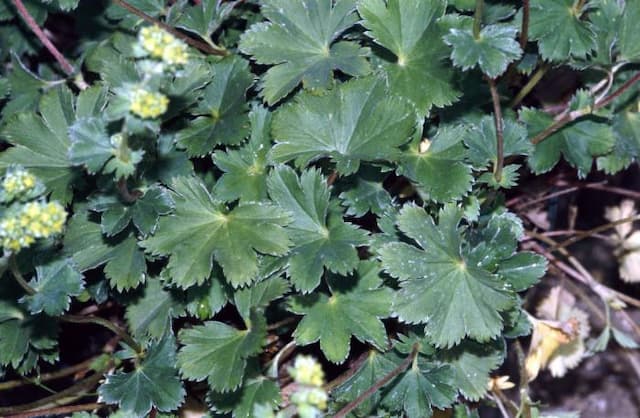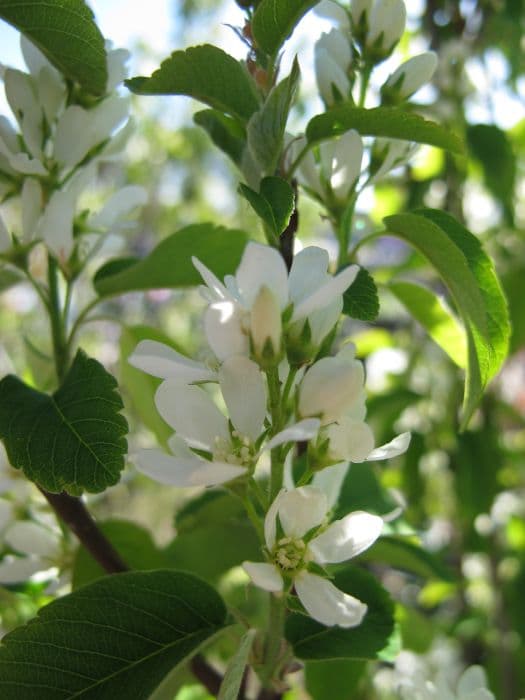Multiflora rose Rosa multiflora (Ra)

ABOUT
Rosa multiflora, commonly known as multiflora rose, is a perennial bush adorned with numerous small and delicate flowers. It has a sprawling, vine-like habit and is often found with arching stems. The leaves of the multiflora rose are made up of several small leaflets which are oval-shaped and have a toothed margin, giving them a feathery appearance. Each leaflet is typically bright green and glossy, adding to the lush look of the shrub. The flowers of the multiflora rose are its defining feature. They are small, with a multitude of petals that are typically white to pinkish in color. The blooms form in large clusters, creating a spectacular display when in full bloom. Each individual flower has a classic rose shape, albeit smaller than many other rose varieties, with a subtle sweet fragrance that can be quite noticeable when large numbers are in bloom. After the flowering season, this plant often produces small, hard fruits called rose hips, which are reddish to orange in color and can persist into the fall or even winter, providing visual interest and a food source for wildlife. The plant is also recognizable for its stems, which bear numerous hard, hooked thorns that can make handling the plant quite challenging. These thorns can vary in size and density across different parts of the plant. The multiflora rose has a robust and vigorous growth habit, making it a resilient plant in a variety of conditions, but also a potential invader that can outcompete other plants if not managed properly.
About this plant
 Names
NamesFamily
Rosaceae.
Synonyms
Multiflora Rose, Baby Rose, Japanese Rose, Seven-Sisters Rose, Rambler Rose, Multiflowered Rose.
Common names
Rosa polyantha, Rosa floribunda, Rosa watsoniana, Rosa cathayensis, Rosa miqueliana
 Toxicity
ToxicityTo humans
Multiflora rose is not considered toxic to humans. It does not contain any known toxic substances that would cause poisoning upon ingestion. Therefore, there are generally no symptoms of poisoning associated with the consumption of any part of the multiflora rose plant.
To pets
Multiflora rose is also not considered toxic to pets. It does not have poisonous properties that would harm animals if they were to ingest parts of the plant. No symptoms of poisoning are expected if pets consume multiflora rose. However, as with any non-food plant material, ingestion of large amounts might lead to gastrointestinal upset purely due to the ingestion of non-digestible matter.
 Characteristics
CharacteristicsLife cycle
Perennials
Foliage type
Deciduous
Color of leaves
Green
Flower color
White
Height
10-15 feet (3-4.6 meters)
Spread
10-15 feet (3-4.6 meters)
Plant type
Shrub
Hardiness zones
5
Native area
East Asia
Benefits
 General Benefits
General Benefits- Erosion control: Rosa multiflora has a robust root system that helps stabilize soil and prevent erosion.
- Habitat for wildlife: It provides food and shelter for various wildlife species, including birds and beneficial insects.
- Livestock forage: The plant can be used as forage for livestock, particularly goats, in certain areas.
- Aesthetic appeal: With its abundant, fragrant flowers and arching growth, it is often used for ornamental purposes in landscapes.
- Hedging: Its dense growth habit makes it suitable for use as a living fence or hedge, providing privacy and wind protection.
- Soil improvement: The plant’s ability to fix nitrogen can help improve soil fertility over time.
 Medical Properties
Medical Properties- Antioxidant: Rosa multiflora is known to contain antioxidants which can help in neutralizing harmful free radicals in the body.
- Anti-inflammatory: The plant has been reported to possess anti-inflammatory properties that might be useful in reducing inflammation.
- Astringent: Traditionally, the rose hips and petals of Rosa multiflora have been used for their astringent qualities.
- Vitamin C source: The rose hips of the plant are a rich source of Vitamin C, which is important for immune system function and skin health.
 Air-purifying Qualities
Air-purifying QualitiesThis plant is not specifically known for air purifying qualities.
 Other Uses
Other Uses- Rosa multiflora can be utilized for creating living fences or hedgerows due to its rapid growth and dense foliage, providing both privacy and boundary delineation.
- The plant's extensive root system is employed in soil erosion control efforts as it helps stabilize soil in areas prone to erosion.
- Birds are attracted to the rose hips produced by Rosa multiflora, making it a beneficial plant for supporting local avian populations.
- The canes of this plant are used in traditional basket weaving crafts, with the flexible stems suited for creating intricate designs.
- Rosa multiflora is sometimes used in perfumery for its subtle, sweet rose fragrance which is extracted for use in various scented products.
- Landscape artists employ Rosa multiflora for topiary gardens as its growth can be guided and shaped into artistic forms.
- In bonsai, Rosa multiflora's small leaves and potential for miniature growth make it a candidate species for creating rose bonsai trees.
- The plant is used for cover in wildlife habitats, providing shelter and nesting sites for a range of small animals and insects.
- Rosa multiflora is occasionally used as a rootstock for grafting more delicate or ornamental rose species due to its hardiness and vigor.
- Due to its dense and thorny thickets, Rosa multiflora is sometimes strategically planted to deter trespassers and unauthorized access to private property.
Interesting Facts
 Feng Shui
Feng ShuiThe Multiflora Rose is not used in Feng Shui practice.
 Zodiac Sign Compitability
Zodiac Sign CompitabilityThe Multiflora Rose is not used in astrology practice.
 Plant Symbolism
Plant Symbolism- Love: Multiflora roses are part of the Rosa genus, which is typically associated with love and affection in various cultures, symbolizing deep emotion and heart-felt sentiment.
- Beauty: Rosa multiflora, like other roses, is often symbolic of beauty and perfection due to its attractive flowers and sweet fragrance, reflecting the admiration of physical and inner beauty.
- Intricacy: The complex structure of multiflora roses, with their multiple small blossoms, can symbolize the complexity of relationships and the interconnectedness of emotions.
- Invasive Nature: In some areas where Rosa multiflora is considered an invasive species, it may symbolize an uncontrolled spread or overgrowth, reflecting situations that have gotten out of hand.
 Water
WaterMultiflora rose plants should be watered deeply once a week, ensuring that the soil is moist but not waterlogged. During hot, dry periods, increase the frequency to twice a week. A good rule of thumb is to provide about 1 to 1.5 gallons of water per plant each time you water. Ensure the water is distributed evenly at the base of the plant, avoiding wetting the foliage to reduce the risk of fungal diseases. In the winter months, watering can be reduced as the plant goes dormant and requires less moisture.
 Light
LightMultiflora roses thrive best in full sun conditions, which means they need at least six hours of direct sunlight daily. This plant should be placed in a location where it can receive plenty of morning sun, which is less intense than the afternoon sun, reducing stress on the plant. Partial shade is tolerated, but the plant may not produce as many flowers, and its overall health could be affected.
 Temperature
TemperatureMultiflora roses are hardy and can tolerate a range of temperatures, but they perform best when the temperature is between 60 and 70 degrees Fahrenheit. They can survive minimum winter temperatures down to -20 degrees Fahrenheit, making them suitable for many climates. In summer, they can handle temperatures up to 90 degrees Fahrenheit without significant stress.
 Pruning
PruningPruning multiflora roses is necessary to maintain their shape, encourage air circulation, and promote healthy growth. The best time to prune is in late winter or early spring, before new growth begins. Remove any dead, damaged, or diseased canes, as well as any that are crossing or rubbing against each other. Aim to open up the center of the plant to light and air, which helps prevent fungal diseases. Prune the plant every year to keep it vigorous and productive.
 Cleaning
CleaningAs needed
 Soil
SoilMultiflora roses thrive in well-draining soil with a pH between 6.0 and 6.5. For optimum growth, a mix of loam, organic compost, and coarse sand is recommended to ensure good drainage and fertility.
 Repotting
RepottingMultiflora roses should ideally be repotted every two to four years. Repotting is best done during the dormant season, typically in late winter or early spring before new growth starts.
 Humidity & Misting
Humidity & MistingMultiflora roses, also known as Rambler roses, prefer moderate humidity levels. They are adaptable to outdoor conditions and do not require specific humidity control when planted in the garden.
 Suitable locations
Suitable locationsIndoor
Provide bright light, proper watering, and good air flow.
Outdoor
Plant in full sun, well-draining soil, prune yearly in early spring.
Hardiness zone
5-9 USDA
 Life cycle
Life cycleRosa multiflora, commonly known as multiflora rose, begins its life cycle as a seed, often dispersed by birds and animals that eat its fruit. Upon finding a suitable environment with ample sunlight and well-drained soil, the seed germinates, typically in early spring. The seedling then develops into a rapidly growing, thorny shrub, establishing a robust root system. As it matures, multiflora rose produces numerous clusters of small, white to pinkish flowers in late spring to early summer, which are pollinated by insects. Following pollination, the flowers develop into small, red rose hips (fruits), which persist on the plant into winter and provide food for wildlife. The plant can also spread vegetatively through root suckers and stem layers, thereby expanding its growth and completing the life cycle.
 Propogation
PropogationPropogation time
Spring-Early Summer
The most popular method of propagating Rosa multiflora, commonly known as multiflora rose, is through softwood cuttings. This technique is typically carried out in late spring or early summer when new growth is mature enough yet still flexible. To propagate by softwood cuttings, select a healthy stem and cut a piece about 4 to 6 inches long, ensuring there are at least a few leaves present. Dip the cut end of the stem in a rooting hormone to encourage root growth. Then insert the cutting into a well-draining soil mix, and keep it moist and covered with a plastic bag to maintain humidity until roots develop. The cutting should be placed in indirect light and checked regularly for root formation, which usually occurs within 4 to 8 weeks. Once established, the new Rosa multiflora plants can be transplanted to their permanent location.









